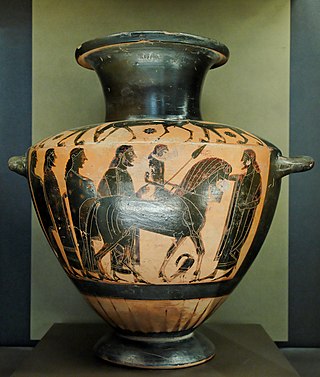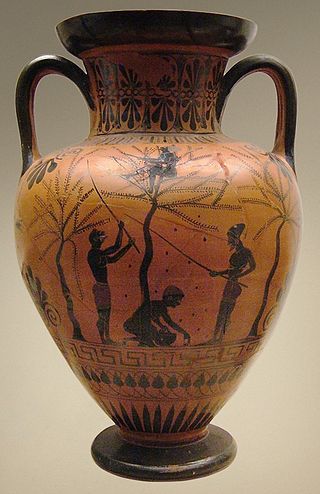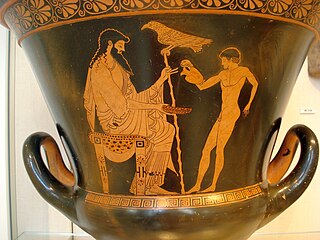
The Lysippides Painter was an Attic vase painter in the black-figure style. He was active around 530 to 510 BC. His conventional name comes from a kalos inscription on a vase in the British Museum attributed to him; his real name is not known.

The Lysippides Painter was an Attic vase painter in the black-figure style. He was active around 530 to 510 BC. His conventional name comes from a kalos inscription on a vase in the British Museum attributed to him; his real name is not known.
His conventional name is derived from a kalos inscription on a neck amphora in the British Museum (B 211). He is considered the most significant pupil of Exekias, from whom he adopted not only his artistic style but also some important motifs, such as Ajax and Achilleus playing a board game. He also frequently painted scenes involving the hero Herakles. In total, about 30 known vases are ascribed to him.
His collaboration with the Andokides Painter, usually considered the inventor of red-figure vase painting, is unusual. On seven bilingual vases, six belly amphorae and a cup (now in Palermo), he painted the red-figure side, while the Andokides Painter was responsible for the black-figure one. At times, the subjects painted by both are identical. It remains disputed amongst scholars whether both painters are identical and merely represent one artist using both techniques. Already John Beazley saw them as separate artists, an argument later developed by Beth Cohen and Heide Mommsen. The identity of the two painters is supported by Konrad Schauenburg, Herbert Marwitz and John Boardman. Martin Robinson and others remained undecided.
The Lysippides Painter's works consisted of many neck-amphorae that were based on the works of Exekias, his mentor. Lysippides' works however, were simplified compared to those of Exekias. This style actually became very popular in the Archaic Period. Especially showing in the late 6th century and early 5th as his neck-amphorae stand on the front lines of a series of vases. [1] Many of his works were extremely similar to Exekias. A vase in Detroit depicts the mythical Greek hero, Herakles wrestling a lion. This depiction takes after a neck-amphorae version done by Exekias in multiple ways. While there is no saying that Lysippides is the painter, the vase is grouped with his work stylistically in the way it takes after Exekias and that the work narrows all the attention on Herakles' role in the battle rather than the lion's. These elements are strongly associated with the work of the Lysippides Painter. [2] Like most artists during this time, his work contained many religious references of Greek gods and goddesses in his work. Herakles being one of the more popular.
Of the 204 vases attributed to the Lysippides Painter in the Beazley Archive, there are over 60 of Herakles in various forms of heroism, fighting the lion, mounting chariots with Athena, fighting Amazons (Amazonomachy), and fighting giants (Giantomachy). He is almost always shown in his lion cape, with hood resting on the back of his black hair, defined with white paint. The arms of the lion are tied around his chest (where muscles are also well defined with white lines).


Of the 204 vases attributed to Lysippides P in the Beazley archives, 112 are large amphorae. These contain all variations of Amphorae, Amphora A, Amphora B, Amphora Neck, and 4 Panathenaic Amphorae. There are also 32 cups consisting of Cup A and Little Master Band Variations. The basins of many of these large cups are decorated with the face of a gorgonian. These Gorgonians are typical of the Nikostenes workshop to which, it has been argued, Lysippides was occasionally lent. Some of the other shapes that Lysippides works with are Krater, Columns, Oinchoes, Psykters, and Pyxis. These shapes have very small numbers, but many of them carry the same subjects as those of other Lysippides vases.
Most of the Lysippides Painter's vases appear to have been traded to Italy, especially the area around Rome, Etruria. Of the 85 vases that have listed provenances, 74 were shipped to Italy and over of 50 of these to the Etruria region. The other provenances include Sicily, Egypt and Turkey, but they appear in nominal numbers.
Front and back: Achilles and Ajax playing a board game [6] [7]

Black-figure pottery painting, also known as the black-figure style or black-figure ceramic, is one of the styles of painting on antique Greek vases. It was especially common between the 7th and 5th centuries BCE, although there are specimens dating as late as the 2nd century BCE. Stylistically it can be distinguished from the preceding orientalizing period and the subsequent red-figure pottery style.

Exekias was an ancient Greek vase painter and potter who was active in Athens between roughly 545 BC and 530 BC. Exekias worked mainly in the black-figure technique, which involved the painting of scenes using a clay slip that fired to black, with details created through incision. Exekias is regarded by art historians as an artistic visionary whose masterful use of incision and psychologically sensitive compositions mark him as one of the greatest of all Attic vase painters. The Andokides painter and the Lysippides Painter are thought to have been students of Exekias.
Oltos was a Late Archaic Greek vase painter, active in Athens from 525 BC to 500 BC. About 150 works by him are known. Two pieces, a cup in Berlin and a cup in Tarquinia, are signed by him as painter.

The Berlin Painter is the conventional name given to an Attic Greek vase-painter who is widely regarded as a rival to the Kleophrades Painter, among the most talented vase painters of the early 5th century BCE.

Nikosthenes was a potter of Greek black- and red-figure pottery in the time window 550–510 BC. He signed as the potter on over 120 black-figure vases, but only nine red-figure. Most of his vases were painted by someone else, called Painter N. Beazley considers the painting "slovenly and dissolute;" that is, not of high quality. In addition, he is thought to have worked with the painters Anakles, Oltos, Lydos and Epiktetos. Six's technique is believed to have been invented in Nikosthenes' workshop, possibly by Nikosthenes himself, around 530 BC. He is considered transitional between black-figure and red-figure pottery.

Lydos was an Attic vase painter in the black-figure style. Active between about 560 and 540 BC, he was the main representative of the '’’Lydos Group’’’. His signature, ό Λυδός, ho Lydos ", inscribed on two vases, is informative regarding the cultural background of the artist. Either he immigrated to Athens from the Lydian empire of King Kroisos, or he was born in Athens as the son of Lydian parents. In any case, he learned his trade in Athens.

The Antimenes Painter was an Attic vase painter of the black-figure style, active between circa 530 and 510 BC.

Psiax was an Attic vase painter of the transitional period between the black-figure and red-figure styles. His works date to circa 525 to 505 BC and comprise about 60 surviving vases, two of which bear his signature. Initially he was allocated the name "Menon Painter" by John Beazley. Only later was it realised that the artist was identical with the painters signing as "Psiax".

The Amasis Painter was an ancient Greek vase painter who worked in the black-figure technique. He owes his name to the signature of the potter Amasis, who signed twelve works painted by the same hand. At the time of the exhibition, "The Amasis Painter and His World" (1985), 132 vases had been attributed to this artist.

Andokides was an ancient Athenian vase painter, active from approximately 530 to 515 B.C. His work is unsigned and his true name unknown. He was identified as a unique artistic personality through stylistic traits found in common among several paintings. This corpus was then attributed by John D. Beazley to the Andokides Painter, a name derived from the potter Andokides, whose signature appears on several of the vases bearing the painter's work. He is often credited with being the originator of the red-figure vase painting technique. To be sure, he is certainly one of the earliest painters to work in the style. In total, fourteen amphorae and two cups are attributed to his hand. Six of the amphorae are "bilingual", meaning they display both red-figure and black-figure scenes.

The Pan Painter was an ancient Greek vase-painter of the Attic red-figure style, probably active c. 480 to 450 BC. John Beazley attributed over 150 vases to his hand in 1912:
Cunning composition; rapid motion; quick deft draughtsmanship; strong and peculiar stylisation; a deliberate archaism, retaining old forms, but refining, refreshing, and galvanizing them; nothing noble or majestic, but grace, humour, vivacity, originality, and dramatic force: these are the qualities which mark the Boston krater, and which characterize the anonymous artist who, for the sake of convenience, may be called the 'master of the Boston Pan-vase', or, more briefly, 'the Pan-master'.

Eucharides Painter is the common nickname of an ancient Greek artist who decorated but did not sign Attic vases. Neither his real name, nor the dates of his birth and death are known. Presumably this artist was a pupil of the Nikoxenos Painter.

Amasis was an ancient Attic potter, active in Athens between 560/550 and 530/520 BC. Amasis’s pottery workshop also employed a well-known painter, who is conventionally named the Amasis Painter after the potter, and generally considered one of the best Archaic vase painters. His works are mostly black-figure, but some red-figure vase paintings by him do occur. He and Exekias produced the first major painted amphorae with a narrative image on front and back, respectively. Famous works:

Group E was a group of Attic vase painters of the black-figure style. They were active between 560 and 540 BC.

The Phrynos Painter was an Attic black-figure vase painter, active in Athens between c. 560 and 545 BC. He was allocated the conventional name "Phrynos Painter" after the potter Phrynos, as he had painted three cups signed by the latter:
The Princeton Painter was an Attic black-figure vase painter, active in the third quarter of the sixth century BC, just after Group E. His real name is not known.

The Euphiletos Painter was an Attic black-figure vase painter active in the second half of the sixth century BC.

Bilingual vase painting is a special form of ancient Greek vase painting. The term, derived from linguistics, is essentially a metaphorical one; it describes vases that are painted both in the black-figure and in the red-figure techniques. It also describes the transitional period when black-figure was being gradually replaced in dominance by red-figure, basically the last quarter of the 6th and the very beginning of the 5th century BC. Their appearance may be due to the initial uncertainty of the market for the new red-figure style, although that style subsequently became dominant rather fast.

The Mastos Painter was a painter of ancient Greek vases. He is named for a black-figure mastos used by the art historian John Boardman to illustrate the type, which is shaped like a woman's breast.
The Neck Amphora by Exekias is a neck amphora in the black figure style by the Attic vase painter and potter Exekias. It is found in the possession of the Antikensammlung Berlin under the inventory number F 1720 and is on display in the Altes Museum. It depicts Herakles' battle with the Nemean lion on one side and the sons of Theseus on the other. The amphora could only be restored for the first time almost a hundred and fifty years after its original discovery due to negligence and political difficulties.